This article is about the 1940 film. For other uses, see Pinocchio (disambiguation).
Pinocchio is the second film in the Disney Animated Canon. It was produced by Buena Vista Distribution and was originally released to theatres by RKO Radio Pictures on February 7, 1940. The film was theatrically re-released in 1945, 1954, 1962, 1971, 1978, 1984, and 1992. Pinocchio was made in response to the enormous worldwide success of Snow White and the Seven Dwarfs. Based on the book Pinocchio by Carlo Collodi, the film stars a cricket who becomes the conscience of a wooden marionette - brought to life by a fairy - as they face the challenges and dangers of a dark and hostile world of crooks, villains and monsters.
Though Snow White and the Seven Dwarfs is generally considered to be Walt Disney's most significant contribution to cinema, Pinocchio is considered his greatest achievement and representative of the Disney studio at the peak of its golden age, as well as one of the greatest achievements in animation. Many people list it as their favorite Disney movie because they had many memories watching the movie. Many people consider Pinocchio to be one of the most critically acclaimed of all the Disney animated features and one of the greatest animated films of all time, Pinocchio has never been commercially successful, perhaps as a result of its dark atmosphere and several intense and frightening sequences. On its first release, Disney only recouped about half of its $2.6 million budget in 1940.
The plan for the original film was considerably different from what was released. Numerous characters and plot points, many of which came from the original novel, were used in early drafts. Walt Disney was displeased with the work that was being done and called a halt to the project midway into production so that the concept could be rethought and the characters redesigned. It was at this stage that the character of the cricket was expanded. Jiminy Cricket, voiced by Cliff Edwards, became central to the story.
The song "When You Wish Upon a Star," became a major hit and is still identified with the film, and later as a fanfare for Walt Disney Studios itself. Pinocchio also won the Academy Award for Best Song and the Academy Award for Best Scoring of a Musical Picture. The film has been deemed "culturally significant" by the Library of Congress and in 1994 was selected for preservation in the United States National Film Registry, and in the second slot, behind only Snow White and the Seven Dwarfs, in the American Film Institute’s Top ten Animated Feature Films of all time in 2008. The film is constantly considered the greatest film in the animation medium, despite the inital failure
Plot
Gepetto's Workshop
The film opens with Jiminy Cricket singing When You Wish Upon A Star as he sits on a bookshelf, on which can be found various literary classics, such as Peter Pan, Alice in Wonderland and Pinocchio, which is given a place of prominence. Jiminy Cricket greets the audience and acknowledges that many may not believe that a wish, as the song states, may come true, and, as proof of the message, decides to tell the story of Pinocchio. He slides down the shelf to the Pinocchio book and opens it, beginning his story in a peaceful village at night, which Jiminy states he was passing through. At this point, the viewer enters the story Jiminy is telling through an illustration in the book.
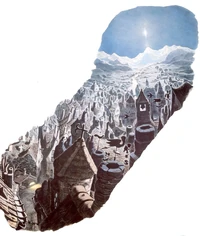
Pinocchio's village is introduced at night, with only Gepetto's workship showing signs of activity. Inspirational sketch by Gustaf Tenggren
The only building from which light seems to eminate is Gepetto's Workshop. Jiminy hops over to the open window and peers in to see a warm fire in a room filled with beautifully carved toys, clocks, music boxes and puppets. He enters the room and warms himself by the fire. At this point, he notices Pinocchio , at this point a fully-carved, clothed but mouthless marionette, sitting on a shelf. He hops over for a closer look; as he is admiring the puppet, he hears someone coming. Crawling up the marionette's strings to hide on a high shelf, he sees Gepetto coming down the stairs with Figaro to finish painting the puppet. Gepetto greets Cleo, whose bowl sits nearby, and carefully paints a smile on the puppet's face. Having completed the marionette he gives it the name "Pinocchio" (which literally means "Little Wooden Head") and tests it out by walking it around the workshop, to the tune of Little Wooden Head which is played by one of the music boxes. The bells of the clocks that cover the walls of the workshop indicate that it is now nine o'clock, and Gepetto announces that it is time for bed. After he, Figaro and Cleo have bidden each other goodnight, the woodcutter gets into bed, to notice a Wishing Star through the window. He wishes that Pinocchio would become a real boy, before falling asleep.

The Blue Fairy enters the workshop and grants Pinocchio life. Inspirational sketch by Gustaf Tenggren
The Blue Fairy
Jiminy's initial attempts to get to sleep are hindered by the clocks' ticking and Gepetto's snoring. After finally getting some peace and quiet, he is wakened by a blue light; the wishing star is glowing brighter, and getting closer to the window; eventually, reaching the workshop, it transforms into the Blue Fairy. She approaches Pinocchio and, fulfilling Gepetto's wish, brings the puppet to life with a tap of her wand. Pinocchio is delighted and surprised at his ability to move and talk. The Blue Fairy informs him, however, that he is not a real boy yet, and must prove himself good, caring and unselfish to become a real boy, and learn the difference between right and wrong. After Jiminy hops in to explain to Pinocchio, the Blue Fairy dubs the cricket Pinocchio's conscience and leaves, warning that Pinocchio always let his conscience be his guide.
Jiminy tries to explain the conept of right and wrong, and, though he is largely unsuccessful, Pinocchio tells him that he wants "to do right". Jiminy then sings Give A Little Whistle, and Pinocchio joins in, falling into a pile of toys by mistake. This wakes Gepetto, who cautiously searches the room. On finding Pinocchio moving and talking, he first thinks he is dreaming, but is eventually convinced, and delighted, that his 'son' is alive. Winding the music boxes, Gepetto, Pinocchio, Figaro and Cleo celebrate. Pinocchio is distracted by a candle and, not knowing what it is, sets his finger on fire; Gepetto panics and extinguishes the wooden boy's finger in Cleo's bowl. He decides that they should go to sleep before anything else happens.
On the way to School
The next morning, the village is awake. The boys and girls hurry to school, and Pinocchio excitedly says goodbye to Gepetto, schoolbook and an apple for teacher in hand. He is noticed by a fox and cat, who, knowing the value of a moving puppet without strings, "befriend" him, intending to sell him. The fox introduces himself as Honest John and tells Pinocchio that he is just the type to become an actor. He and Gideon (the cat) lead him through the streets, while Honest John sings "Hi-Diddle-Dee-Dee (An Actor's Life For Me)". Jiminy, meanwhile, is "late on his first day", and tries to catch Pinocchio's attention by jumping on the Fox's hat. Gideon, trying to hit the cricket, hits Honest John on the head with a hammer, forcing his hat over his eyes and momentarily preventing him from seeing what is happening while the cat tries to pry the hat off. Jiminy tells Pinocchio not to give in to temptation, but is ignored, and Pinocchio accompanies the fox and cat to "be an actor" while Jiminy desperately runs after them.

Stromboli locks Pinocchio in a cage, warning him that failure to put on a good show will have him thrown into the fire. Inspirational sketch
Stromboli, the Puppet Master
Honest John takes Pinocchio to Stromboli's Caravan, where puppet master Stromboli buys the wooden boy and makes him his star attraction. That evening, Jiminy watches from a lamp post as Pinocchio performs I've Got No Strings for the audience, and is met with enthusiastic applause as onlookers throw money on to the stage, much to Stromboli's delight and Jiminy's surprise. Thinking that he was wrong in trying to stop Pinocchio, Jiminy decides to let the living puppet continue without him. Gepetto, meanwhile, is worried that Pinocchio has not returned from school, and leaves the workshop to look for him. It begins to rain. In Stromboli's caravan, after the show, the puppet master congratulates Pinocchio for making him so much money, and tells him that he will become a star. Delighted, Pinocchio makes to leave to go home to Gepetto but is stopped by Stromboli, who grabs him and throws him into a wooden birdcage. He tells the wooden boy that he will keep him there, taking him out only to put on shows as they tour the world. When Pinocchio is too old to entertain audiences, Stromboli will use him for firewood. Laughing, Stromboli leaves the carriage, slamming the door. The caravan begins to move, and Pinocchio weeps as he tries to whistle for his conscience.

Foulfellow and Gideon tell Pinocchio about Pleasure Island. Inspirational sketch by Gustaf Tenggren
The Nose of Deceit
Jiminy is outside in the rain, watching the caravan pass. He decides to wish Pinocchio good luck and to say goodbye to him, and is surprised to find Pinocchio locked up rather than "sitting in the lap of luxury" as Pinocchio tells Jiminy that Stromboli is going to chop him into firewood. He tries to unlock the cage but fails. He stays with Pinocchio as the two weep over their predicament. Geppetto passes the caravan, but his cries for Pinocchio are not heard above the rain and thunder. When all hope seems lost, the Blue Fairy appears in the caravan. She asks Pinocchio why he did not go to school; the wooden boy lies, telling her that he and Jiminy were captured by monsters. His nose grows longer with each lie that he tells, until it has become a tree limb, complete with leaves and a bird's nest. The Blue Fairy tells Pinocchio that a lie keeps growing, "until it's as plain as the nose on your face". Pinocchio promises to be good, and his nose shrinks back to normal size. The Blue Fairy frees Pinocchio from the cage and vanishes, saying that this is the last time she can help. Jiminy and the wooden boy sneak out of the caravan as it is moving.
The Plot
Meanwhile, the fox and cat are celebrating at The Red Lobster. Seated opposite them is the Coachman, who listens to Honest John's story and decides to catch his attention with a huge bag of money, which he says can be theirs if they bring "stupid little boys" to the crossroads for him to take to Pleasure Island. Though Foulfellow is at first terrified of getting caught, the Coachman assures him that none of the boys ever come back "as boys." As soon as they leave the tavern, the fox and cat find Pinocchio racing Jiminy Cricket home, and pretend to be doctors, stating that he is 'allergic' and must go to Pleasure Island to get better. They carry him to the crossroads with Jiminy once again in hot pursuit. When on the Coachman's Stagecoach, Pinocchio meets a brat named Lampwick, who tells him that Pleasure Island is a "swell joint" where boys can run riot without fear of reprimand from authority figures and everything is freely available. The coach reaches the shore, where the boys board a boat which takes them to the island.

The Coachman cracks his whip, ordering his minions to lock the doors.
Pleasure Island

Lampwick completely turned into a donkey and about to bray.
As the boys enjoy themselves at the fairground-like Pleasure Island, the Coachman orders his minions to close the doors, locking the unknowing boys in. Later that night, Jiminy searches the now-deserted farground for Pinocchio. He eventually finds him playing pool with Lampwick, who scoffs that Pinocchio "takes orders from a grasshopper" and laughs at Jiminy, shooting the cricket down the pool gutter when he admonishes him. Jiminy

Alexander and other donkeys that can still talk.
loses his temper and leaves, quiting as Pinocchio's Conscience after discovering that Pinocchio is friends with Lampwick. He crawls under the main doors of the fairground to find the Coachman and his minions loading donkeys into crates that go to places such as the Salt Mines and the Circus. One donkey, named Alexander, is able to speak. The Coachman throws Alexander into a pen of donkeys that "can still talk". Jiminy realizes that the donkeys are the same boys that went to Pleasure Island after seeing an unseen sign reminding "Jackasses of Themselves", meaning that the boys were somehow transformed into donkeys and are now being sold into slavery. He rushes back to warn Pinocchio. Back in the pool hall, Lampwick is still laughing about Jiminy saying that something bad is going to happen when he suddenly sprouts donkey ears, causing Pinocchio to immediately stop drinking. Much to Pinocchio's terror, this is followed by a tail, so he stops smoking. As his face transforms, Lampwick asks if Jiminy thinks he looks like a jackass. Pinocchio says he does, only to bray when trying to laugh. When Lampwick's laugh becomes a donkey's bray as well, he then covers his mouth and asks "Did that come out of me?", to which Pinocchio nods, he then looks in the mirror and panics. He asks Pinocchio for help, but the wooden boy is only able to look on in fright. Lampwick's last words are a frantic call for his mother before he turns into a donkey completely. Lampwick still has his consciousness, though, and in his awful fright he then starts to kick everything on the pool hall, breaking a mirror and a table, and kicking his clothes off. A speechless Pinocchio hides behind a chair, and his panic increases when he himself sprouts ears and a tail, but Jiminy arrives just in time and reminds him that Pleasure Island is cursed and takes him to an escape route in order to avoid transforming into a complete donkey and, together, they swim to the shore of the mainland with Pinocchio only having a donkey tail and ears, leaving Lampwick and the others to die.
In the Belly of Monstro
Pinocchio and Jiminy arrive at Geppetto's workshop to find that the old woodcutter has left, along with Figaro and Cleo. A message from the Blue Fairy informs Pinocchio of his father's location: after venturing out to sea to rescue Pinocchio from Pleasure Island, he had been swallowed by Monstro, an enormous whale. Pinocchio resolves to save Geppetto; though Jiminy tries to warn him against it, he accompanies the wooden boy. Tying a rock to his donkey tail, Pinocchio plunges to the bottom of the sea and he and Jiminy begin their search for Monstro. Any sea creatures they ask flee at the mere mention of Monstro's name, and none provide any help.

Monstro
Inside the belly of the whale, Gepetto is in a small boat with Figaro and Cleo. They have nothing to eat; Geppetto fears that, unless Monstro opens his mouth soon, they will starve to death. Monstro wakes from his slumber to surprise a school of tuna, who flee in all directions; Pinocchio and Jiminy see Monstro and, terrified, try to swim to escape; Pinocchio is swallowed but the sprightly Jiminy manages to escape. Pinocchio finds himself on Geppetto's boat, and the woodcarver's surprise at his son's donkey ears and tail is outweighed by his relief at seeing his son again. Geppetto laments that they cannot get out of the whale, who only opens his mouth to eat. However, Pinocchio has a plan; gathering wood together, he starts a fire, which causes Monstro to sneeze the boat out. Jiminy jumps on as they fly past. Furious, Monstro chases the boat and smashes it to pieces with his tail. Pinocchio takes hold of his father and paddles for a hole in the cliffs beyond as a means of escape. Monstro, enraged as ever, continues to chase after them. Pinocchio and Gepetto succeed in getting through the hole in the cliff just as Monstro crashes into it, which causes the whale a fatal head trauma, thus ensuring the end of Monstro. Gepetto, Jiminy, Figaro and Cleo wash up on shore alive, but Pinocchio is seen floating face down in a deep puddle, apparently having died trying to save his father.
Epilogue
In Gepetto's workshop, Jiminy, Gepetto and the pets mourn Pinocchio's death. However, in saving his father, Pinocchio has proved himself; the Blue Fairy, from afar, grants him life, and he becomes a real boy. While the other characters celebrate, Jiminy, standing on the window ledge, gazes at the Wishing Star and thanks the Blue Fairy. As a reward, a gold medal declaring him an 'Official Conscience' appears on his front.
Cast
- Dickie Jones as Pinocchio, a happy wooden puppet carved by Geppetto and turned into a living puppet by the Blue Fairy. Jones also voices Alexander, one of the boys who transformed into a donkey on Pleasure Island. Alexander can still talk and is hurled into a special holding pen for suchlike donkeys. Pinocchio was animated by Milt Kahl, Frank Thomas and Ollie Johnston whilst Alexander was animated by Eric Larson.
- Cliff Edwards as Jiminy Cricket, a cheerful cricket who acts as Pinocchio's "conscience" and the partial narrator of the story. Jiminy Cricket was animated by Ward Kimball.
- Christian Rub as Mister Geppetto, a woodcarver who creates Pinocchio and wishes for him to become a real boy. He was animated by Art Babbitt.
- Figaro and Cleo, Geppetto's tuxedo cat and goldfish, respectively, who do not like each other very much until the end of the film when Pinocchio becomes a real boy. They were animated by Eric Larson. Mel Blanc offers a brief voice act for Figaro, during the scene where Figaro sneezes.
- John Worthington Foulfellow (Walter Catlett), also known as Honest John, is a sly anthropomorphic red fox and known criminal who tricks Pinocchio twice in the film. He was animated by Norm Furgeson.
- Gideon, Honest John's mute and crafty anthropomorphic feline accomplice. He was originally intended to be voiced by Mel Blanc of Looney Tunes fame (in his only work for Disney until Who Framed Roger Rabbit), but the filmmakers deleted his dialogue in favor of a mute performance (e.g. Harpo Marx) just like Dopey of Snow White and the Seven Dwarfs. However, Gideon's hiccups were provided by Blanc. Gideon was animated by Norm Ferguson.
- Charles Judels as Stromboli, a large, sinister, bearded puppet maker who forces Pinocchio to perform onstage in order to make money. He speaks in an Italian accent, though he is identified as a gypsy. He is the only villain of the film to be part of the official Disney Villains line-up. Judels also voices the devious and sadistic Coachman, owner and operator of Pleasure Island, who enjoys turning unruly boys into donkeys. He speaks in a Cockney accent. Stromboli was animated by Bill Tytla whist the Coachman was animated by Charles August Nichols.
- Evelyn Venable as The Blue Fairy, who brings Pinocchio to life and turns him into a real boy at the end. She was animated by Jack Campbell.
- Frankie Darro as Lampwick, a naughty boy Pinocchio befriends on his way to Pleasure Island, who is turned into a donkey on Pleasure Island. He was animated by Fred Moore.
- Thurl Ravenscroft as Monstro, the sperm whale that swallows Geppetto, Figaro, and Cleo during their search for Pinocchio. Pinocchio is later swallowed when Monstro is eating and he and Geppetto reunite. Monstro's whale sounds were provided by Thurl Ravenscroft, and he was animated by Wolfgang Reitherman.
Beginnings
| I take the liberty of calling to your attention again to the use of the language and the pronunciation... It is a masterwork full of episodes and fit to be developed. —Lo Duca in a letter dated July 4, 1935 |
It is clear that Walt Disney had been aware of Pinocchio long before deciding to adapt it for animation; Roy E. Disney recalled his uncle reading the story of Pinocchio to him before bed. However, Disney does not seem to have considered it for a feature until it was suggested by Ben Sharpsteen. Mrs. K. Evers, a family friend, suggested it for a short subject in a letter of April 8,1935. On his holiday in Europe Disney had met Lo Duca, an Italian journalist, who was similarly enthusiastic that Disney adapt it, urging him that it was 'fit to be developed' in a letter of
Title Card for Pinocchio
July 4, 1935.
The title Pinocchio had been registered as a feature in May 1934. Collodi's original story, Le avventure di Pinocchio first appeared in serial form in 1881, and was published as a book in 1883. An English translation of story was published in America in 1911. Walt Disney owned the original Italian edition and several different English translations of the tale, and in 1937 Bianca Majolie, a member of the story department, made a new translation. A play by Yasha Frank, based on the original story, was published in 1939 but performed earlier; Disney circulated a memo on June 9, 1937 recommending that his artists will see the play, and consider it as material for a feature. However, due to the pressure to complete Snow White and the Seven Dwarfs, story meetings for Pinocchio do not appear to have begun until March 24, 1938. Story work for Bambi was begun in 1937, before the release of Snow White and the Seven Dwarfs and earlier than that of Pinocchio. Thinking that the animal characters of Bambi would be easier to animate than the predominantly human cast of Pinocchio, Disney expected Bambi to be completed first. By December 1937, however, it seemed Pinocchio would be the first to be ready for release.
Production
Story Development
It is thought that Walt Disney showed less enthusiasm in story meetings for Pinocchio than in those for Snow White. Anxious to increase the output of his studio - he intended at this point to release, in addition to short cartoons, two or more features every year - he seemed eager to move onto the animation stage as quickly as possible. As a result, the story was split into sections; The first, consisting of scenes introducing Pinocchio, Gepetto, Figaro (at this point an old tomcat) and the Blue Fairy, was prepared in a scene-by scene format. Animation begun in early 1938. It was not until February of that year that Disney began to show more interest, finding potential in the scenes featuring Monstro the whale.
The Character of Pinocchio
The story men found Collodi's original story difficult to adapt. Originally written in serial form, the story was, as a result, episodic and needed to be cut down considerably in order to work in the feature film format. The primary problem, however, was the protagonist; Pinocchio himself was an impudent rogue, often guilty of cruelty in the original story. His wooden body would surely make the character even less sympathetic with audiences. In early story treatments for the film, Pinocchio retains his malice, at one point trapping the old tomcat's tail in a vice. Emphasis was also placed on the boy's wooden body, as he was teased for his appearance by boys, and sniffed at by a curious dog, on the way to school. As animation had, by this time, begun, but no voice had yet been found, animators Frank Thomas and Ollie Johnston worked from the sped up voice of story man Ted Sears, intended as a temporary measure. However, Disney was still unhappy with the character of Pinocchio, and halted production until a solution could be found. The degree of humanity in the living puppet had yet to be determined and fine-tuned. In early April 1938, however, scenes featuring other characters had been written and were being animated.
Though Fred Moore had attempted to design Pinocchio in a more appealing way, it was Milt Kahl who was responsible for the character's redesign. Kahl approached the character as though he was an ordinary boy, rather than a wooden puppet; the joints and nails could simply be drawn in afterwards. At the request of Hamilton Luske, Kahl illustrated his ideas by animating the scene in which Pinocchio dives into the sea in search of Monstro and Gepetto. The little wooden boy became less mischievous and more passive, wandering innocently into the hostile world that awaited him. Though Disney himself found this to be an excellent idea, giving the go-ahead for the opening scene's animation to be continued in September, some were unsure, including Wilfred Jackson, who would later admit that the change removed 'the guts of the whole story', as a more human Pinocchio in his puppet form made his transformation into a real boy less gratifying.
Design
Inspirational Sketch Artists
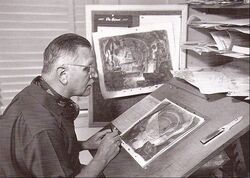
Albert Hurter working on the design of Pinocchio in 1939
As with Snow White and the Seven Dwarfs, Albert Hurter designed the characters, objects and locations featured in Pinocchio, and was responsible for the overall styling of the film. Hurter's influence are particularly apparent in the scenes in Gepetto's Workshop, in which nearly every object is designed to resemble a face or creature of some sort; every object in the workshop was designed by Hurter, then realised as a three-dimensional (often working) model. However, the inspirational sketch artist whose style is perhaps most prevalent in the final film was Gustaf Tenggren, who had already made his name as an illustrator before joining the studio in 1936. Tenggren reinforced the influence of European Illustration on the film (having worked as successor to John Bauer for the magazine Bland Tomar och Troll); he also kept files and cuttings on favourite American painters (such as Thomas Hart Benton, Grant Wood and Edward Hopper) and shots from Hollywood films.
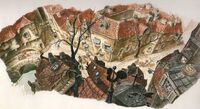
Gustaf Tenggren's inspirational sketch of an aerial view of the village demonstrates the influence of American painters and Hollywood films of the time
These influences can be seen in Tenggren's inspirational sketches for the film, in which composition is made dynamic by a 'fish-eye lens' effect, depth is emphasized by exaggeration of perspective, and figures and buildings are characterized by sharpened, immaculate edges. During his time at the studio, Tenggren did not socialize with the other artists and animators, who felt that the talented artist was too proud to want to compromise on the styling of the film. Tenggren left the studio a year before the film's release and, controversially, received no credit for the film; despite this, he is generally considered (with the possible exception of Mary Blair) to be the most influential artist on the visual style of Disney's films.
The Character Model Department
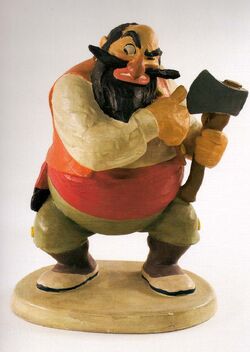
A model of Stromboli
Joe Grant had designed both the Queen and her alter-ego, the Witch, and had been responsible, along with Wlliam Cottrell, for both characters' scenes in Snow White and the Seven Dwarfs. During production on Snow White, several crude models - including armatures for the dwarfs and a plasticine Snow White head - had been constructed as reference for the animators. Grant's more detailed plasticine model of the Witch did not go unnoticed by Walt Disney, who, when passing him in a studio hallway one day, asked him to "set up a little department": a "think tank" which would be responsible for the design and construction of models for use by the animators and their assistants. Interestingly, Disney did not include Cottrell in his proposal; it is thought that separating the team of Grant and Cottrell was intended as a reassertion of Disney's power.
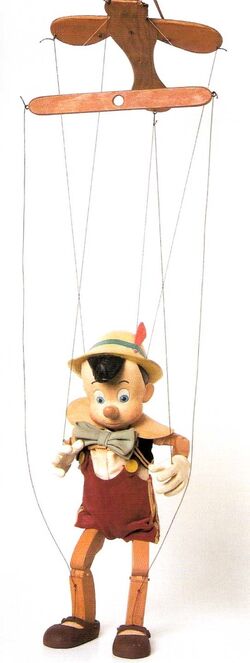
A working Pinocchio marionette constructed as reference for the animators.
In setting up the Character Model Department, Grant recruited the studio's best artists; over the years the department included, among others, Jack Miller, Bob Jones, Martin Provenson, Cambell Grant, John Wallbridge, Fini Rudiger, Tom Codrick, Mary Blair, Aurelius Battaglia, James Bodrero, Kay Nielsen and Albert Hurter. Most artists would produce sketches and model sheets. At Disney's suggestion,eventually three-dimensional models were constructed. Charles Christadoro, Ted Kline, Lorna Soderstrom and Duke Russell were responsible for sculpting the clay models; these models were then fired in a kiln in Grant's own backyard, and painted by women from the Ink and Paint Department, including Helen Nervobig. Models were constructed of every character, including Pinocchio as a marionette, as well as Stromboli's Caravan, The Coachman's Stagecoach and all of Gepetto's Toys and Clocks. Many model sheets were also produced with designs for the fish Pinocchio encounters in the sea. The artists of the Character Model Department were also responsible for developing ideas, and were heavily involved with the story development of Pinocchio and many of the segments in Fantasia.
Next to Disney himself, Grant was the most powerful man in the studio during production on Pinocchio and Fantasia; he was increasingly relied on to make creative decisions and was determined to "appeal to Walt to stimulate him and to raise (himself) in his esteem." All sketches and model sheets had to by stamped 'O.K. J.G.' (indicating Grant's approval of the design) before being used by the animators. The animators did not regard the Character Model Department fondly, often angry both at Walt's increased attention paid to it and what they believed to be very little effort put in on the part of the artists, "who could sit and whistle and make a pretty thing without much effort". Grant's department, correspondingly, saw the animators as "a hundred percent yokel". The disdain shown by each group for the other increased at the construction of the expensive new Burbank studio, which placed the Character Model Department on the third floor (near Disney's office) and the animators, on the first.

An inspirational sketch by Gustaf Tenggren particularly reminiscent of the work of Arthur Rackham
The Disney Studio Library
During production on Snow White and the Seven Dwarfs Walt Disney had purchased nearly 700 books from various countries in Europe, considering their illustrations (by such famous illustrators as Arthur Rackham and Gustave Dore) to be useful in the visual development of his cartoons and features. The influence of European illustration is thus apparent not only in Snow White but also Pinocchio and, later, Fantasia; though Disney himself was not knowledgeable about art, others at the studio, particularly Grant and Albert Hurter, were, and were responsible for many of the influences found in films such as Pinocchio. Gustaf Tenggren had also been hired because of his knowledge of European illustration, and the manner in which he incorporated it into his own art; Tenggren was himself an illustrator and had succeeded John Bauer as illustrator of the Swedish annual Bland Tomtar och Troll; his style is strongly reminiscent of Bauer in particular.
Another illustrator whose work strongly influenced the design of Pinocchio was Gustave Dore. The intensity, theatrical staging and satirical grotesquery of many of Dore's illustrations (of which the illustrator's art for Dante's Divine Comedy, the Bible, Don Quixote and Cervantes were best known) was appropriate for the visual styling of Pinocchio. Dore's work was known by all of the Disney artists, and a number of copies of The Divine Comedy and Paradise Lost could be found in the Disney Studio Library. The use of shadows and a dark palette in the Pleasure Island sequences is particularly reminiscent of the brooding darkness found in much of Dore's work. Like Dore's @#!*% (in illustrations for Dante's Inferno), Pleasure Island is surrounded by water, has hellish residents, and has a rocky, barren landscape.
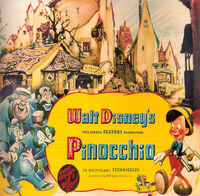
A 1940 poster for the film
Reception and Critical Reaction
Upon its 1940 release, Pinocchio was not financially successful. It was thought by many to be too dark a film for family audiences. Though there are dark elements in Snow White and the Seven Dwarfs, these evil forces are vanquished in the film's climax; in comparison, four of the villains of Pinocchio (Honest John, Gideon, The Coachman, and Stromboli) continue their deeds unpunished. It is thought by some that the use of multiple villains in the film is a reflection of complexity of the Deppression (following the Second World War, most Disney films would be characterized by a single villain). The dark themes of the film are also thought to be a result of the film's European sources, particularly Collodi's original story (the darkness of which Disney nevertheless attempted to lessen in his adaptation) and a mise en scene heavily influenced by German Expressionism. Intense sequences, such as Stromboli's imprisonment of Pinocchio, Lampwick's transformation and Monstro's scenes, were deemed particularly frightening for young audiences. Perhaps most importantly, the Second World War had cut off Disney's European market, preventing the exhibition of Pinocchio (and, later that year, Fantasia) in Europe. It has been speculated that this cut off an audience which may have been more ready to accept the film than Americans, given the film's strong European influences.

1992 Re-Release Poster
Despite not being a commercial success, the film remains the most critically acclaimed of all the Disney animated features. Archer Winsten, who had been critical of Snow White and the Seven Dwarfs, had nothing but praise for Pinocchio. The New Yorker's review was similarly positive, arguing that "it befits us to take Pinocchio to our hearts with gratitude and pleasure." While many audiences complained about the absence of a romance, some critics praised the film for staying away from over-sentimentality. Richard Mallett (Punch) wrote, "is it better than Snow White and the Seven Dwarfs? I think it is, much better, not in spite of (as at least one reviewer said) but partly because of the absence of so much conscious sentiment and charm." The film is also considered the most technically brilliant film in the Disney animated features canon. Review aggregator website Rotten Tomatoes reports that 100% of the critics gave the film a positive review based on 41 reviews. Pinocchio is one of a handful of films to achieve a 100% "Fresh" rating on Rotten Tomatoes.
Release
- Main article: Pinocchio (video)
In the Disney Parks
Pinocchio has been a part of the Disney parks since the early days with When You Wish Upon A Star having served as an anthem of sorts for the project. Several characters appear as walkarounds including Pinocchio himself, Gepetto, Jiminy Cricket, Honest John, Gideon, Stromboli and the Blue Fairy. The film has also received a dark ride, Pinocchio's Daring Journey, which exists at Disneyland, Tokyo Disneyland and Disneyland Paris.
Other usages of the film in the parks include:
- Storybook Land Canal Boats, where the boats enter through Monstro's mouth and the village is seen as one of the locations
- The Main Street Electrical Parade, long hosted by the Blue Fairy and having featured various Pinocchio units such as Monstro and Pleasure Island
- Pinocchio Village Haus, a restaurant in several versions of Fantasyland.
- Fantasmic!, which includes Jiminy and Monstro in both US versions, with a I've Got No Strings sequence at the Disneyland version
- Jiminy Cricket has hosted various night-time shows at Magic Kingdom, such as the parade SpectroMagic and Wishes!
Pinocchio is a common choice for day-time parade float themes, featuring in both Disneyland's Walt Disney's Parade of Dreams and the Magic Kingdom's Celebrate A Dreams Come True Parade, which it shares with Snow White.
Difference from source material
- Jiminy Cricket (or the Talking Cricket as he was called in the original Italian tale) actually dies early on when he tries to lecture Pinocchio on his bad behavior, only to have the puppet brain him with a hammer. He reappears later on as an equally preachy ghost, then inexplicably reappears alive again towards the end.
- Geppetto actually gets arrested through some meddling townsfolk who misinterpret his attempts to discipline the naughty Pinocchio for child abuse.
- Stromboli was originally called "Mangiafoco" ("Fire-Eater"), and despite his terrifying appearance, was capable of kindly impulses.
- The fairy was usually referred to as the fairy with blue hair (turquoise actually), and there was no indication she was responsible for Pinocchio coming to life. Also she had a entourage of intelligent animals at her command, including a poodle who acted as her coachman, a team of mice to pull her coach, and a snail who acted as her house-keeper and messenger.
- Pleasure Island was originally called "Toyland" ("Il Paese dei Balocchi").
- It was a giant shark not a whale that swallows first Geppetto, then Pinocchio, in the original story.
Allusions
- Two books labelled "Alice in Wonderland" and "Peter Pan" are visible in the very first shot of the film. Alice in Wonderland was released 11 years after Pinocchio, with Peter Pan immediately following two years later.
Trivia
- The main song, When You Wish Upon A Star, was parodied in the Family Guy episode "When You Wish Upon A Weinstein, where Peter Griffin sings "I Need A Jew" when he foolishly spends his family's savings on volcano insurance and asks for financial help. Walter Murphy and Seth MacFarlane were sued by the owner of the rights to the song.
- The film is also parodied in The Simpsons episode, Itchy & Scratchy Land.
- Originally released on February 7, 1940.
- One of the few Disney film whose antagonists receive little to no consequences for their actions.
- Pleasure Island's name may have been a play on Treasure Island, a novel by Scottish author Robert Louis Stevenson, which, coincidentally, inspired Treasure Island and Treasure Planet.
Gallery
External links
- Template:Imdb title
- Pinocchio on Lux Radio Theater: December 25, 1939. Adaptation of Disney film.
| v - e - d | ||||||||||||||||
|---|---|---|---|---|---|---|---|---|---|---|---|---|---|---|---|---|
|
Template:Animated Feature-nav



